Cases of ingestion of indoor poisonous plants are relatively common among animals and lead to both acute cases of poisoning and long-term exposure to harmful substances and chronic damage to the animal’s health. Plants produce a large number of secondary metabolites, which serve to protect the plant from attacks by insects, parasitic plants, fungi or, for example, during reproduction. However, these metabolites can be toxic if ingested by animals or humans. Toxicologically effective components found in plants are mainly alkaloids, glycosides, saponins, terpenes and others.
For the full References please check the original article (https://www.mdpi.com/2072-6651/15/5/346).
- aroid plants
- bulb plants
- euphorbias
- lily
- cyclamen
1. Introduction
2. House Plants
2.1. Aroid Plants (Araceae)
Plants from the arum family include, for example, dieffenbachia/dumbcane (Dieffenbachia spp., Figure 1), monstera plants (Monstera deliciosa, Figure 2, M. aff. adansonii or Monkey Mask, Figure 3, karsteniana, etc., or Raphidophora tetrasperma, known as Monstera minima), philodendrons (Philodendron spp., Figure 4), the syngonium/arrowhead plant (Syngonium spp., Figure 5), the anthurium/flamingo flower (Anthurium spp., Figure 6), peace lily (Spatiphyllum, Figure 7), calla lily (Zantedeschia aethiopica, Figure 8), devil’s ivy (Epipremnum spp., incorrectly called pothos, Figure 9), satin pothos/silver pothos (Scindapsus spp.), caladium/elephant ears (Caladium spp.), Chinese evergreen (Aglaonema spp., Figure 10), alocasia/elephant ears (Alocasia spp.), etc.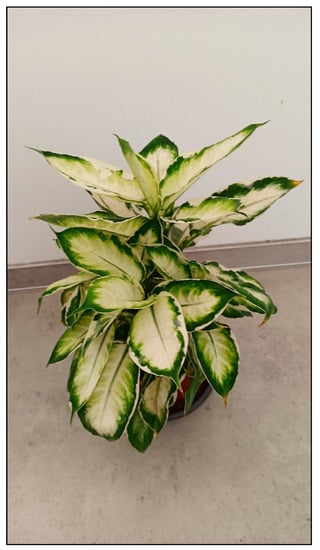
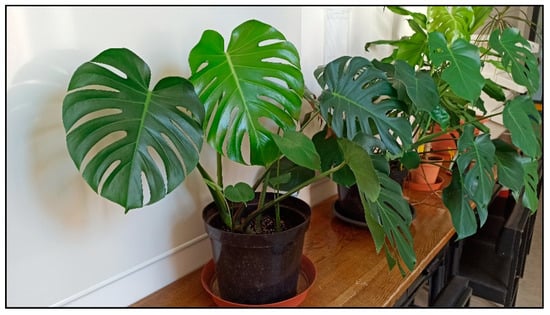
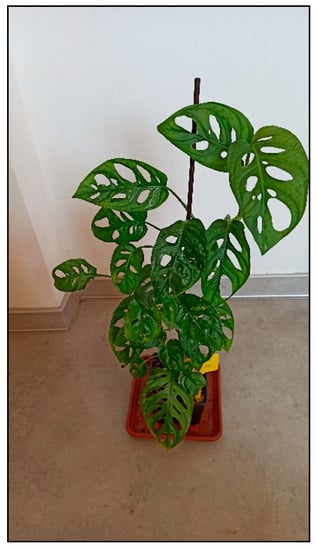
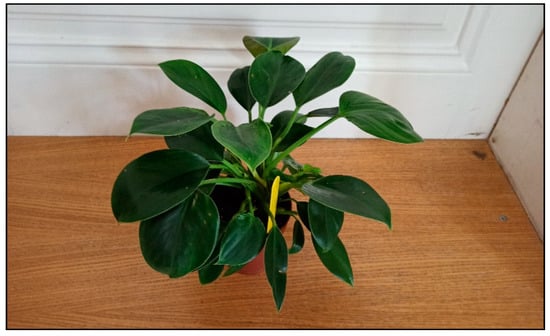
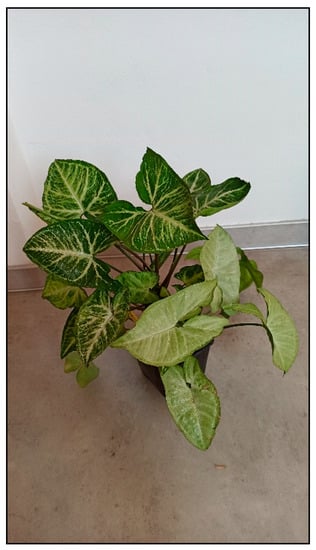
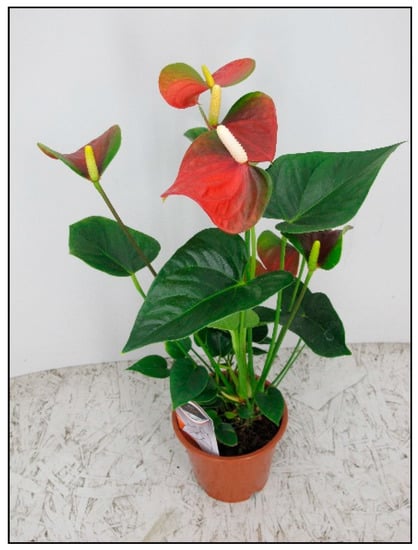
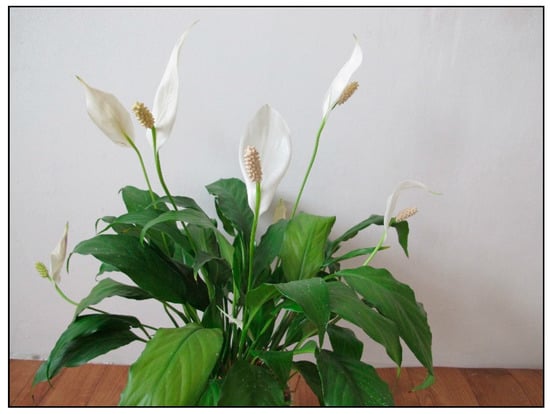
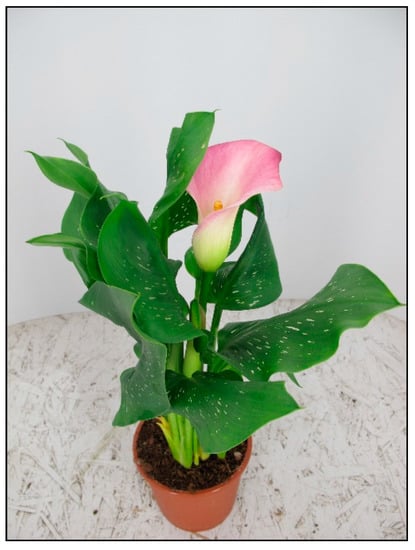
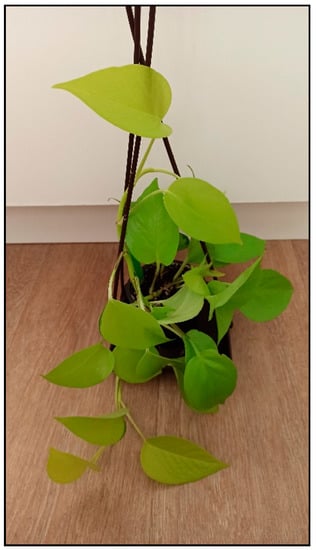
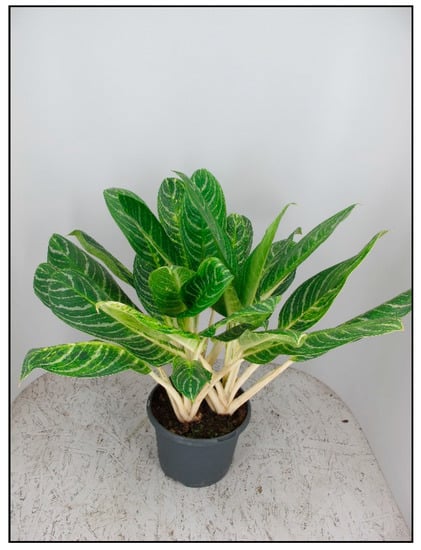
2.2. Euphorbia/Spurge Plants (Euphorbiaceae)
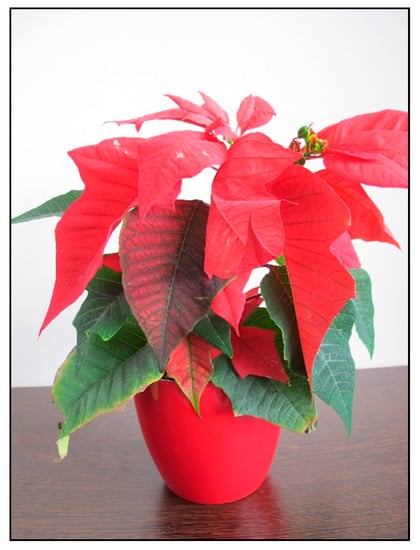
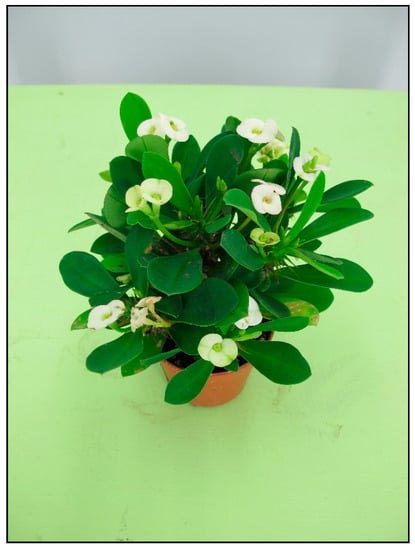

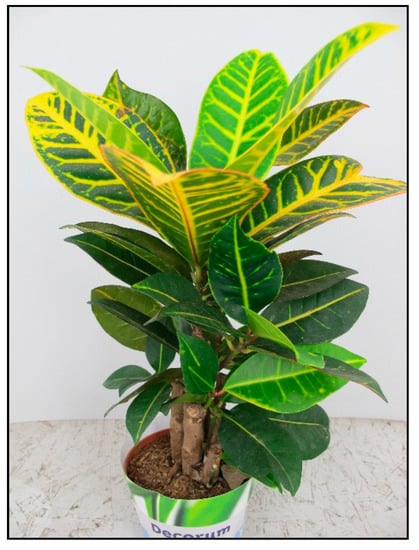
2.3. Cyclamens (Cyclamen spp.)
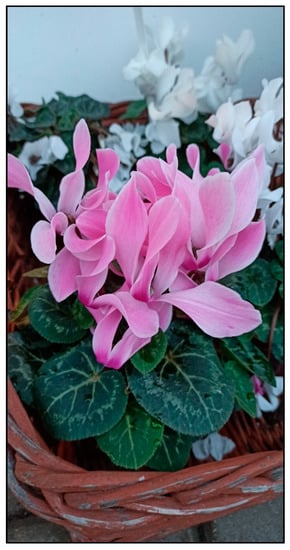
2.4. Dracaena (Dracaena spp.), Cordyline (Cordyline spp.), Snake Plant/Mother-In-Law’s Tongue (Sansevieria spp.)
There are many species and color varieties of dracaena plant (Figure 16 and Figure 17) and cordyline plant. Like mother-in-law’s tongues (Figure 18), they belong to the asparagus family (Asparagaceae), but sometimes they are also included in the agave family (Agavaceae); these families are intermingled. One of the species belonging to this group is Dracaena sanderiana (Figure 19), which is sold under the misleading name lucky bamboo.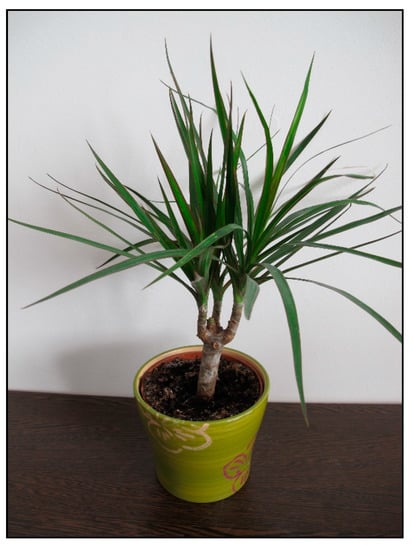
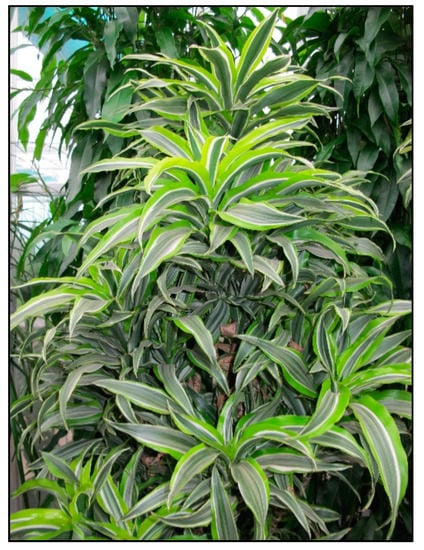
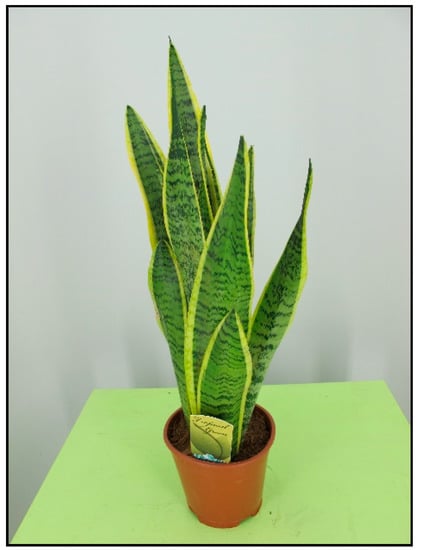
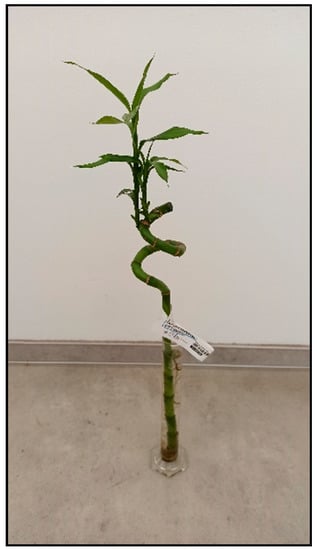
2.5. Bulb Plants
In households, bulb plants appear most often during winter and early spring as single-use decorative plants (e.g., tulips, daffodils, hyacinths, crocuses, and grape hyacinths; Figure 20, Figure 21 and Figure 22), or year-round plants, e.g., clivias (Clivia minata, Figure 23), hippeastrum/Barbados lily (Hippeastrum x hortorum, Figure 24) or amaryllis (Amaryllis belladonna). These plants usually belong to the Amaryllidaceae or Liliaceae families (formerly a joint family).
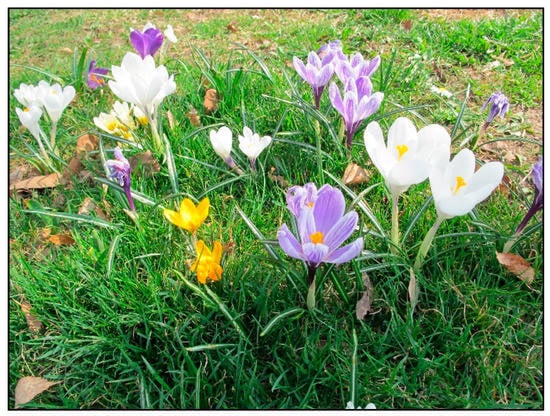
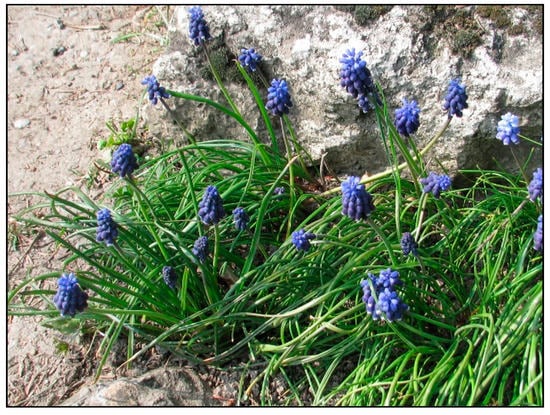
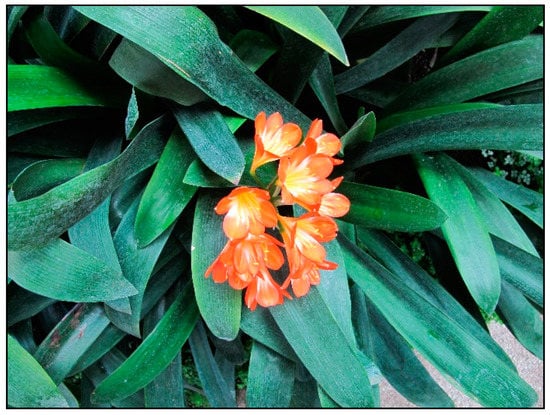
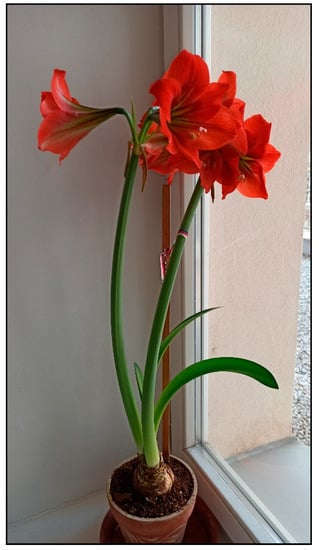
2.6. Lilies (Easter Lily, Asiatic, Oriental and Other Lily Hybrids, generally Lilium spp.)
Lilies (Figure 25) are bulb plants that belong to the Liliaceae family; in addition to garden growing, they can be also kept as potted indoor plants and often appear in homes as cut flowers. Although they can also cause mild gastrointestinal symptoms due to oxalates, the main risk resulting from consumption lies in the possibility of developing kidney damage or even kidney failure, which is described specifically in cats. The substance that causes renal toxicity is unknown.
2.7. Common/English Ivy (Hedera helix)
The mechanism of action of saponins is interference with lipids in the cell membrane and a change in its permeability and later integrity. The cells of the mucous membranes and the skin are affected locally, and after absorption hemolysis also occurs. In ivy, damage to hepatocytes is also possible, but usually does not occur in acute poisonings. Polyins (mainly falcarinol and its derivates) are irritants and allergens which interact with proteins in the cells. These are also found in other indoor plants from the Araliaceae family such as Fatsia japonica (Figure 26), ivy tree (Fatshedera), Schefflera arboricola or actinophylla (Figure 27).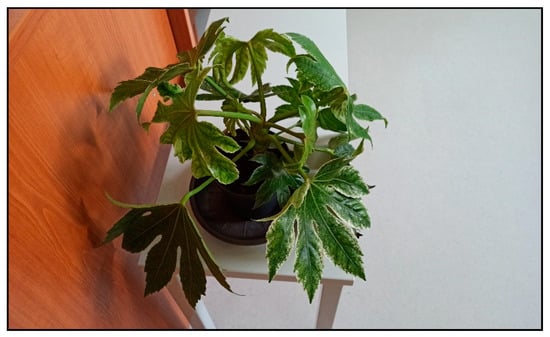
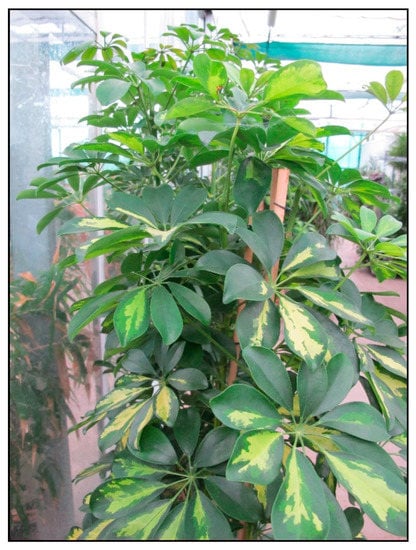
2.8. Mistletoe (Viscum album)
2.9. Oleander/Nerium (Nerium oleander)
Among other plants causing winter poisoning in domestic animals and summer poisoning in rodents or tortoises kept in summer enclosures is oleander (Figure 28), which must be kept indoors during the winter in many mild- to cold-climate countries, because it is not frost-resistant. It belongs to the dogbane family (Apocynaceae) and contains cardiac glycosides. These are also found in indoor plants such as kalanchoe (Kalanchoe blossfeldiana, Figure 29) or desert rose (Adenium obesum, Figure 30).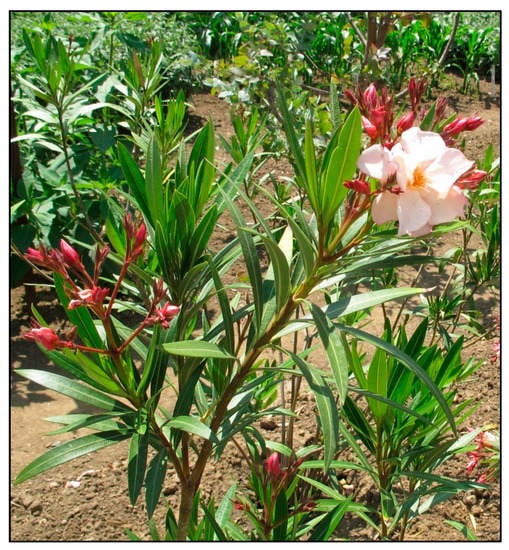
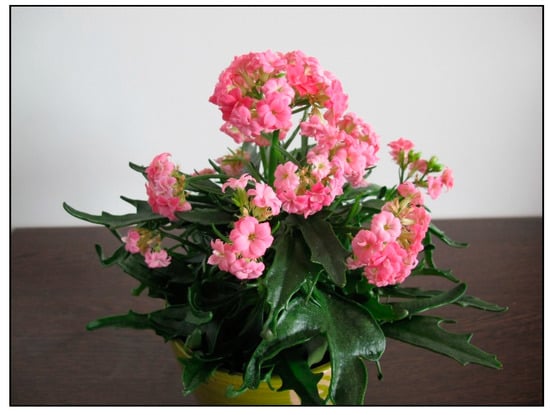
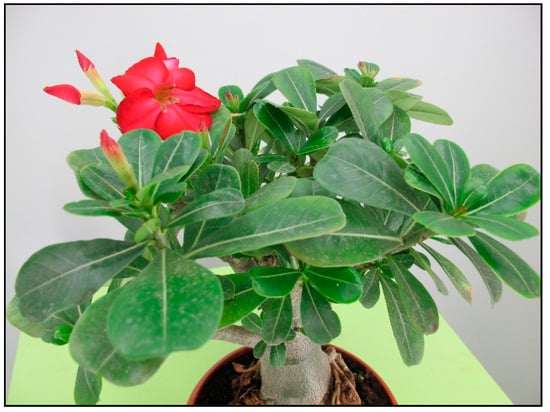
2.10. Plants Containing Pyrrolizidine Alkaloids
Among the indoor plants, these substances are mainly contained in the genus Senecio (e.g., string of pearls, S. rowleyanus, Figure 31, or S. barbertonicus) from the Asteraceae family. Rabbits and rodents (with the exception of the rat) are relatively less sensitive to these plants. Poisoning usually manifests itself only after chronic consumption of such plants, while acute poisonings are rare. Poisonings from house senecios are less frequent and less serious than outdoor senecio/ragwort poisonings.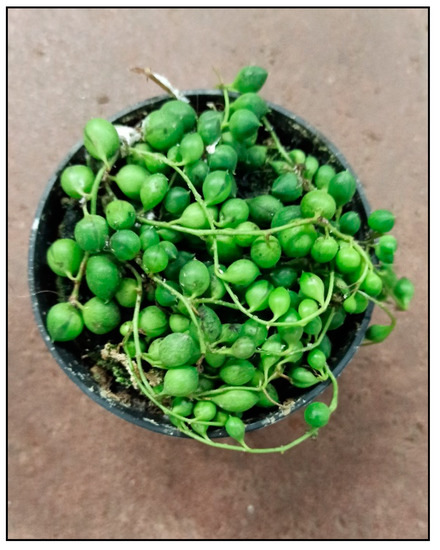
2.11. Plants Causing Allergic Reactions and Other Toxic Plants
2.11.1. Allergenic Plants
Allergic reactions are usually caused by skin contact with the plant, but can also occur after ingesting the plant. The most common symptom is skin irritation. Representatives of this type of toxicity include some wax plants (Hoya spp.), chrysanthemums (Chrysanthemum spp.), coleus (Coleus spp.), ficuses/fig plants (Ficus elastica—Figure 32, Ficus benjamina—Figure 33, Ficus benghalensis, Ficus lyrata, etc.), poison primrose (Primula obconica), African milk bush (Synadenium grantii), aralia (Polyscias spp.), geranium (Pelargonium spp.), spiderwort and creeping inch plants (Tradescantia and Callisia spp.). or citrus plants.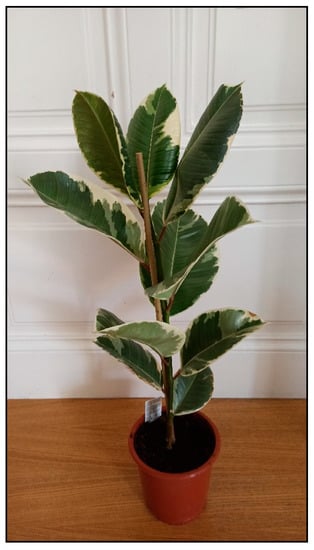
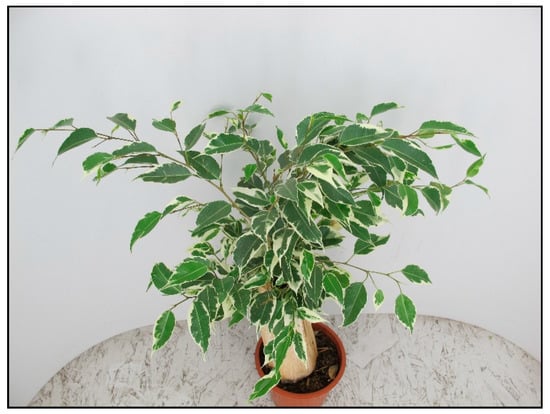
2.11.2. Other Toxic Plants That Are Grown in Households
Rhododendrons and azaleas (Rhododendron spp., Figure 34) contain diterpene grayanotoxin. Its mechanism of action is prolonged sodium channel activation and cell depolarization which then leads to overstimulation of the central nervous system. This causes salivation, vomiting, diarrhea, dyspnea, muscle weakness, convulsions, and comas. The cardiovascular effects caused by nervus vagus impairment may include hypotension, sinus bradycardia or bradyarrhythmia and partial or complete atrioventricular block. Signs may persist several days. Some sources also mention miosis as a clinical sign.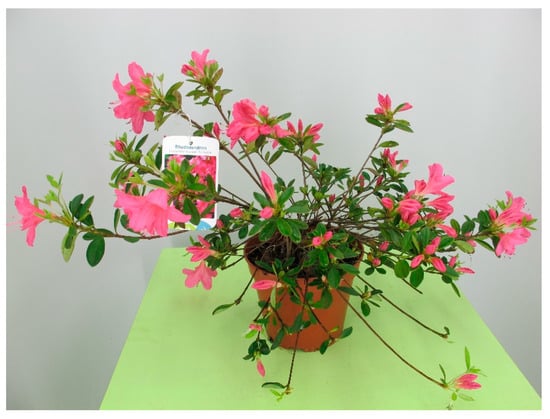
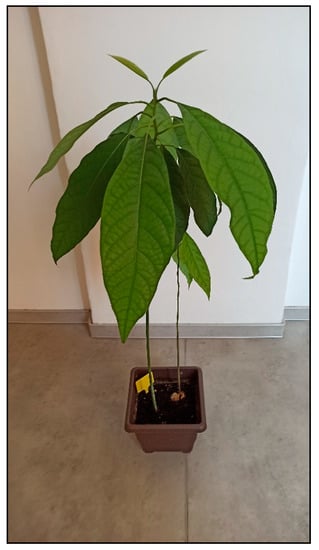
Afaszek, L.; Garbal, M.; Kutrzuba, J.; Winiarczyk, S.; Kwiecinski, P. Przypadki zatruc draceną u kotow. Zycie Weter. 2009, 84, 655–657. (In Polish) [Google Scholar]
Aguirre, L.S.; Sandoval, G.V.; Medina, D.M.; Martinez, O.G.; Micheloud, J.F. Acute heart failure in rabbits by avocado leaf poisoning. Toxicon 2019, 164, 16–19. [Google Scholar] [CrossRef]
Altin, G.; Sanli, A.; Erdogan, B.A.; Paksoy, M.; Aydin, S.; Altintoprak, N. Severe Destruction of the Upper Respiratory Structures after Brief Exposure to a Dieffenbachia Plant. J. Craniofac. Surg. 2013, 24, e245–e247. [Google Scholar] [CrossRef]
Bandara, V.; Weinstein, S.A.; White, J.; Eddleston, M. A review of the natural history, toxinology, diagnosis and clinical management of Nerium oleander (common oleander) and Thevetia peruviana (yellow oleander) poisoning. Toxicon 2010, 56, 273–281. [Google Scholar] [CrossRef] [PubMed]
Basak, S.K.; Bakshi, P.K.; Basu, S.; Basak, S. Keratouveitis caused by Euphorbia plant sap. Indian J. Ophthalmol. 2009, 57, 311–313. [Google Scholar] [CrossRef]
Bertero, A.; Davanzo, F.; Rivolta, M.; Cortinovis, C.; Vasquez, A.; Le Mura, A.; Masuelli, A.; Caloni, F. Plants and zootoxins: Toxico-epidemiological investigation in domestic animals. Toxicon 2021, 196, 25–31. [Google Scholar] [CrossRef]
Cao, Z.; Yang, P.; Zhou, Q. Multiple biological functions and pharmacological effects of lycorine. Sci. China Chem. 2013, 56, 1382–1391. [Google Scholar] [CrossRef]
Cohen, A.K.; Theotoka, D.; Galor, A. Epipremnum aureum Keratopathy: Case report and review of the literature. Eye Contact Lens Sci. Clin. Pract. 2020, 46, e33–e39. [Google Scholar] [CrossRef]
Fitzgerald, K.T. Lily Toxicity in the Cat. Top. Companion Anim. Med. 2010, 25, 213–217. [Google Scholar] [CrossRef]
Freitas, M.S.; Pereira, A.H.B.; Pereira, G.O.; Menezes, I.S.; Lucena, A.R.; Almeida, C.R.F.; Pereira, E.G.; Santos, L.A.; Tozin, L.R.S.; Alves, F.M.; et al. Acetogenin-induced fibrotic heart disease from avocado (Persea americana, Lauraceae) poisoning in horses. Toxicon 2022, 219, 106921. [Google Scholar] [CrossRef]
Frohne, D.; Pfänder, H.J. Poisonous Plants, 2nd ed.; Manson Publishing Ltd.: London, UK, 2005; 469p. [Google Scholar]
Gupta, R.C. (Ed.) Veterinary Toxicology, 3rd ed.; Academic Press: London, UK, 2018; 1205p. [Google Scholar]
Huerth, K.A.; Hawkes, J.E.; Meyer, L.J.; Powell, D.L. The Scourge of the Spurge Family—An Imitator of Rhus Dermatitis. Dermatitis 2016, 27, 372–381. [Google Scholar] [CrossRef] [PubMed]
Jansen, S.A.; Kleerekooper, I.; Hofman, Z.L.M.; Kappen, I.F.P.M.; Stary-Weinzinger, A.; van der Heyden, M.A.G. Grayanotoxin Poisoning: ‘Mad Honey Disease’ and Beyond. Cardiovasc. Toxicol. 2012, 12, 208–215. [Google Scholar] [CrossRef]
Kahn, C.M. (Ed.) The Merck Veterinary Manual, 10th ed.; Merck & Co. Inc.: Whitehouse Station, NJ, USA, 2010; pp. 2675–2717. [Google Scholar]
Kienle, G.S.; Grugel, R.; Kiene, H. Safety of higher dosages of Viscum album L. in animals and humans-systematic review of immune changes and safety parameters. BMC Complement. Altern. Med. 2011, 11, 72. [Google Scholar] [CrossRef]
Kralova-Kovarikova, S. Přehled významných nefrotoxických látek psů a koček. Veterinarstvi 2016, 66, 483–491. (In Czech) [Google Scholar]
McLean, M.K.; Hansen, S.R. An Overview of Trends in Animal Poisoning Cases in the United States: 2002–2010. Vet. Clin. Small Anim. Pract. 2012, 42, 219–228. [Google Scholar] [CrossRef] [PubMed]
Loretti, A.P.; Da Silva Ilha, M.R.; Ribeiro, R.E. Accidental fatal poisoning of a dog by Dieffenbachia picta (dumb cane). Vet. Hum. Toxicol. 2003, 45, 233–239. [Google Scholar] [PubMed]
Muller, N.; Glaus, T.; Gardelle, O. Extensive gastric ulceration due to intoxication with Dieffenbachia in a cat. Tierarztl. Prax. Ausg. Kleintiere Heimtiere 1998, 26, 404–407. [Google Scholar]
Nair, J.J.; van Staden, J. Pharmacological and toxicological insights to the South African Amaryllidaceae. Food Chem. Toxicol. 2013, 62, 262–275. [Google Scholar] [CrossRef] [PubMed]
Ozdemir, C.; Schneider, L.A.; Hinrichs, R.; Staib, G.; Weber, L.; Weiss, J.M.; Scharffetter-Kochanek, K. Allergic contact dermatitis to common ivy (Hedera helix L.). Hautarzt 2003, 54, 966–969. [Google Scholar] [CrossRef]
Page, C.; Murtaugh, R.J. Hypoglycemia Associated with Oleander Toxicity in a Dog. J. Med. Toxicol. 2015, 11, 141–143. [Google Scholar] [CrossRef] [PubMed]
Peterson, M.E.; Talcott, P.A. Small Animal Toxicology; Saunders Elsevier: St. Louis, MO, USA, 2006; 1190p. [Google Scholar]
Roberts, D.M.; Gallapatthy, G.; Dunuwille, A.; Chan, B.S. Pharmacological treatment of cardiac glycoside poisoning. Br. J. Clin. Pharmacol. 2016, 81, 488–495. [Google Scholar] [CrossRef] [PubMed]
Rumbeiha, W.K.; Francis, J.A.; Fitzgerald, S.D.; Nair, M.G.; Holan, K.; Bugyei, K.A.; Simmons, H. A comprehensive study of Easter lily poisoning in cats. J. Vet. Diagn. Investig. 2004, 16, 527–541. [Google Scholar] [CrossRef]
Saxon-Buri, S. Daffodil toxicosis in an adult cat. Can. Vet. J. 2004, 45, 248–250. [Google Scholar] [PubMed]
Twardowschy, C.A.; Teive, H.A.G.; Siquineli, F.; Filho, L.D.; Entres, M.; Twardowschy, A.; Werneck, L.C. Trigeminal sensory neuropathy and facial contact dermatitis due to Anthurium sp. Arq. Neuro-Psiquiatr. 2007, 65, 822–825. [Google Scholar] [CrossRef]
Wiedenfeld, H.; Edgar, J. Toxicity of pyrrolizidine alkaloids to humans and ruminants. Phytochem. Rev. 2011, 10, 137–151. [Google Scholar] [CrossRef]
Welch, K. Editorial-Plant toxins. Toxicon 2019, 168, 140. [Google Scholar] [CrossRef]
Yan, X.; Kang, H.; Feng, J.; Yang, Y.; Tang, K.; Zhu, R.; Yang, L.; Wang, Z.; Cao, Z. Identification of Toxic Pyrrolizidine Alkaloids and Their Common Hepatotoxicity Mechanism. Int. J. Mol. Sci. 2016, 17, 318. [Google Scholar] [CrossRef]
- McLean, M.K.; Hansen, S.R. An Overview of Trends in Animal Poisoning Cases in the United States: 2002–2010. Vet. Clin. Small Anim. Pract. 2012, 42, 219–228. [Google Scholar] [CrossRef] [PubMed]
- Zang, L.; Bing, R.S.; De Araujo, A.C.P.; Ferreira, M.P. A Retrospective Study of Small Animal Poisoning at the Veterinary Medical Teaching Hospital from South Region of Brazil. Acta Sci. Vet. 2018, 46, 7. [Google Scholar] [CrossRef]
- Bertero, A.; Davanzo, F.; Rivolta, M.; Cortinovis, C.; Vasquez, A.; Le Mura, A.; Masuelli, A.; Caloni, F. Plants and zootoxins: Toxico-epidemiological investigation in domestic animals. Toxicon 2021, 196, 25–31. [Google Scholar] [CrossRef]
- Welch, K. Editorial-Plant toxins. Toxicon 2019, 168, 140. [Google Scholar] [CrossRef]
- Peterson, M.E.; Talcott, P.A. Small Animal Toxicology; Saunders Elsevier: St. Louis, MO, USA, 2006; 1190p. [Google Scholar]
- Loretti, A.P.; Da Silva Ilha, M.R.; Ribeiro, R.E. Accidental fatal poisoning of a dog by Dieffenbachia picta (dumb cane). Vet. Hum. Toxicol. 2003, 45, 233–239. [Google Scholar] [PubMed]
- Muller, N.; Glaus, T.; Gardelle, O. Extensive gastric ulceration due to intoxication with Dieffenbachia in a cat. Tierarztl. Prax. Ausg. Kleintiere Heimtiere 1998, 26, 404–407. [Google Scholar]
- Altin, G.; Sanli, A.; Erdogan, B.A.; Paksoy, M.; Aydin, S.; Altintoprak, N. Severe Destruction of the Upper Respiratory Structures after Brief Exposure to a Dieffenbachia Plant. J. Craniofac. Surg. 2013, 24, e245–e247. [Google Scholar] [CrossRef]
- Cohen, A.K.; Theotoka, D.; Galor, A. Epipremnum aureum Keratopathy: Case report and review of the literature. Eye Contact Lens Sci. Clin. Pract. 2020, 46, e33–e39. [Google Scholar] [CrossRef]
- Twardowschy, C.A.; Teive, H.A.G.; Siquineli, F.; Filho, L.D.; Entres, M.; Twardowschy, A.; Werneck, L.C. Trigeminal sensory neuropathy and facial contact dermatitis due to Anthurium sp. Arq. Neuro-Psiquiatr. 2007, 65, 822–825. [Google Scholar] [CrossRef]
- Frohne, D.; Pfänder, H.J. Poisonous Plants, 2nd ed.; Manson Publishing Ltd.: London, UK, 2005; 469p. [Google Scholar]
- Basak, S.K.; Bakshi, P.K.; Basu, S.; Basak, S. Keratouveitis caused by Euphorbia plant sap. Indian J. Ophthalmol. 2009, 57, 311–313. [Google Scholar] [CrossRef]
- Huerth, K.A.; Hawkes, J.E.; Meyer, L.J.; Powell, D.L. The Scourge of the Spurge Family—An Imitator of Rhus Dermatitis. Dermatitis 2016, 27, 372–381. [Google Scholar] [CrossRef] [PubMed]
- Afaszek, L.; Garbal, M.; Kutrzuba, J.; Winiarczyk, S.; Kwiecinski, P. Przypadki zatruc draceną u kotow. Zycie Weter. 2009, 84, 655–657. (In Polish) [Google Scholar]
- Kahn, C.M. (Ed.) The Merck Veterinary Manual, 10th ed.; Merck & Co. Inc.: Whitehouse Station, NJ, USA, 2010; pp. 2675–2717. [Google Scholar]
- Saxon-Buri, S. Daffodil toxicosis in an adult cat. Can. Vet. J. 2004, 45, 248–250. [Google Scholar] [PubMed]
- Cao, Z.; Yang, P.; Zhou, Q. Multiple biological functions and pharmacological effects of lycorine. Sci. China Chem. 2013, 56, 1382–1391. [Google Scholar] [CrossRef]
- Nair, J.J.; van Staden, J. Pharmacological and toxicological insights to the South African Amaryllidaceae. Food Chem. Toxicol. 2013, 62, 262–275. [Google Scholar] [CrossRef] [PubMed]
- Rumbeiha, W.K.; Francis, J.A.; Fitzgerald, S.D.; Nair, M.G.; Holan, K.; Bugyei, K.A.; Simmons, H. A comprehensive study of Easter lily poisoning in cats. J. Vet. Diagn. Investig. 2004, 16, 527–541. [Google Scholar] [CrossRef]
- Fitzgerald, K.T. Lily Toxicity in the Cat. Top. Companion Anim. Med. 2010, 25, 213–217. [Google Scholar] [CrossRef]
- Kralova-Kovarikova, S. Přehled významných nefrotoxických látek psů a koček. Veterinarstvi 2016, 66, 483–491. (In Czech) [Google Scholar]
- Ozdemir, C.; Schneider, L.A.; Hinrichs, R.; Staib, G.; Weber, L.; Weiss, J.M.; Scharffetter-Kochanek, K. Allergic contact dermatitis to common ivy (Hedera helix L.). Hautarzt 2003, 54, 966–969. [Google Scholar] [CrossRef]
- Kienle, G.S.; Grugel, R.; Kiene, H. Safety of higher dosages of Viscum album L. in animals and humans-systematic review of immune changes and safety parameters. BMC Complement. Altern. Med. 2011, 11, 72. [Google Scholar] [CrossRef]
- Bandara, V.; Weinstein, S.A.; White, J.; Eddleston, M. A review of the natural history, toxinology, diagnosis and clinical management of Nerium oleander (common oleander) and Thevetia peruviana (yellow oleander) poisoning. Toxicon 2010, 56, 273–281. [Google Scholar] [CrossRef] [PubMed]
- Page, C.; Murtaugh, R.J. Hypoglycemia Associated with Oleander Toxicity in a Dog. J. Med. Toxicol. 2015, 11, 141–143. [Google Scholar] [CrossRef] [PubMed]
- Roberts, D.M.; Gallapatthy, G.; Dunuwille, A.; Chan, B.S. Pharmacological treatment of cardiac glycoside poisoning. Br. J. Clin. Pharmacol. 2016, 81, 488–495. [Google Scholar] [CrossRef] [PubMed]
- Wiedenfeld, H.; Edgar, J. Toxicity of pyrrolizidine alkaloids to humans and ruminants. Phytochem. Rev. 2011, 10, 137–151. [Google Scholar] [CrossRef]
- Yan, X.; Kang, H.; Feng, J.; Yang, Y.; Tang, K.; Zhu, R.; Yang, L.; Wang, Z.; Cao, Z. Identification of Toxic Pyrrolizidine Alkaloids and Their Common Hepatotoxicity Mechanism. Int. J. Mol. Sci. 2016, 17, 318. [Google Scholar] [CrossRef]
- Jansen, S.A.; Kleerekooper, I.; Hofman, Z.L.M.; Kappen, I.F.P.M.; Stary-Weinzinger, A.; van der Heyden, M.A.G. Grayanotoxin Poisoning: ‘Mad Honey Disease’ and Beyond. Cardiovasc. Toxicol. 2012, 12, 208–215. [Google Scholar] [CrossRef]
- Aguirre, L.S.; Sandoval, G.V.; Medina, D.M.; Martinez, O.G.; Micheloud, J.F. Acute heart failure in rabbits by avocado leaf poisoning. Toxicon 2019, 164, 16–19. [Google Scholar] [CrossRef]
- Freitas, M.S.; Pereira, A.H.B.; Pereira, G.O.; Menezes, I.S.; Lucena, A.R.; Almeida, C.R.F.; Pereira, E.G.; Santos, L.A.; Tozin, L.R.S.; Alves, F.M.; et al. Acetogenin-induced fibrotic heart disease from avocado (Persea americana, Lauraceae) poisoning in horses. Toxicon 2022, 219, 106921. [Google Scholar] [CrossRef]
- Gupta, R.C. (Ed.) Veterinary Toxicology, 3rd ed.; Academic Press: London, UK, 2018; 1205p. [Google Scholar]
References
- Bertero, A.; Davanzo, F.; Rivolta, M.; Cortinovis, C.; Vasquez, A.; Le Mura, A.; Masuelli, A.; Caloni, F. Plants and zootoxins: Toxico-epidemiological investigation in domestic animals. Toxicon 2021, 196, 25–31.
- Welch, K. Editorial-Plant toxins. Toxicon 2019, 168, 140.
- Peterson, M.E.; Talcott, P.A. Small Animal Toxicology; Saunders Elsevier: St. Louis, MO, USA, 2006; 1190p.
- McLean, M.K.; Hansen, S.R. An Overview of Trends in Animal Poisoning Cases in the United States: 2002–2010. Vet. Clin. Small Anim. Pract. 2012, 42, 219–228.
